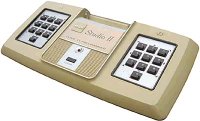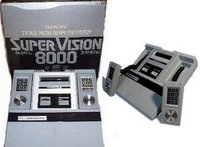
APF Imagination Machine
The APF Imagination Machine is by far one of the most unique systems we have come across. In the late 1970's, a company by the name of APF Technologies released a simple cartridge based system similar to other consoles on the market. The console called the APF M1000 was a simple stand-alone unit that marketed for $130USD and featured a built in game called Game Rocket Patrol. However the M1000 / MP1000 console was merely a portion of the true "Imagination Machine".
 1292 Video System Family
1292 Video System FamilyThe 1292 Advanced Programmable Video System was first created in 1976 by a company called Radofin. Radofin then licensed the technology to other companies throughout the United Kingdom. Acetronic, Prinztronic, Fountain, Grandstand, Audiosonic, Hanimex and Lansay, each made consoles based on Radolfin's design for different parts of the world. Some of these variations were identical to the 1292 Advanced Programmable Video System, but sported different labels based on the maker. Other companies altered the original external design completely.
 Fairchild Channel F
Fairchild Channel FWith so many "Pong" clones on the market at this time, The Fairchild Channel F was a breath of fresh air. The Channel F was the first programmable cartridge based video game console to enter the videogame market. Initially, it was called the "Fairchild Video Entertainment System", but was later changed. It was developed by Fairchild Semiconductors and released in August of 1976.
 RCA Studio II
RCA Studio IIRCA could not let the fact that they let the Odyssey slip through there fingers (Ralph Baer the designer of Odyssey approached RCA with the deal first), and into the hands of there TV rival Magnavox. RCA Studio II was their answer to the Magnavox Odyssey. Released in 1976 a few months after the release of the Fairchild Channel F, it would have been the first programmable console (Fairchild beat them to the release gate).
 Intellivision
IntellivisionIntellivision was released in 1979 by Mattel. It was also released under different names to expand its market. The Intellivision was released in Sears stores as the Super Video Arcade, at Radio Shack as the Tandyvision I, and as the GTE/Sylvania Intellivision.
Intellivision was the main competitor of the Atari 2600. It's graphical capabilities were much better than Atari's console.It was the system to own for playing sports games, but also had a fair amount of action games and strategy games thrown into the mix as well. While Intellivision excelled at graphics and sound, the Atari 2600 was more capable of handling action games due to its superior speed.
 Bandai TV Jack Family
Bandai TV Jack FamilyBandai had been following the videogame industry as both a manufacturer and distributor for years. Bandai had released Pippin, Playdia, and Satellaview (BS-X) in the 1990's, and they distributed Vectrex, Intellivision, and Arcadia.
Before all of those consoles, Bandai introduced a successful console line called "TV Jack" in Japan.
In 1977, Bandai debuted TV Jack 1000 in Japan. The TV Jack 1000 was a color pong unit similar to most pong clones. It contained the on board controllers, and four selectable pong variations (Practice, Tennis, Hockey, Racquetball).
Shortly after that same year the TV Jack 1200 was released. This model allowed for 2 more attachable paddles for 4-player action.
The TV Jack 1500 took things a step further by providing corded paddles (not removable), and 8 selectable built in games.
The TV Jack 2500 was a simple remake of the original model. It supported the same four selectable pong variations (Practice, Tennis, Hockey, Racquetball), but this time each variation had 5 modes (Basically 20 selectable variations). The selling point of this unit was it's size. This model was made small and compact (45cm × vertical 25cm).
The TV Jack 3000 brought back 4-player support, and included 10 selectable built in games.
The TV Jack 5000 was the slight evolution to the console line in 1978. Rather then built in games, this console used cartridges. Not the ROM cartridges of later systems, but carts containing "Pong on a Chip" technology similar to the PC-50X Cart Family. This gave the TV Jack 5000 larger game support.Bandai ended this console line with the TV Jack 8000 a.k.a Bandai Supervision 8000. It was the first programmable cartridge based console to be released in Japan.

VISICOM Video Computer System
The VISICOM Video Computer System Model COM-100 is a remodeled clone of the RCA Studio II, but with small enhancements.
Apparently, the original Studio II should have been a color console, but the units were shipped out with only black & white video output. The VISICOM corrects this issue by allowing Studio II games to be played in NTSC color.
The Studio II also forced players to use the face mounted keypads for directional control. The VISICOM corrected this issue by providing joystick controllers.
The VISICOM was sold in Japan in 1978 for 54,000 Yen.
 Bandai Supervision 8000
Bandai Supervision 8000Bandai had continued their successful TV Jack console line since 1977. The final evolution of the TV Jack series came about in 1979 with the release of TV Jack 8000. This version was named Supervision 8000 or Bandai TV Jack Micro Computer System. This release not only marked the series first programmable cartridge capable console (Actually one of the first Japan cartridge based-systems), but also marked Bandai's attempt to also delve into the computer markets. It was developed with the help of Logic Systems International (L.S.I).
 Bally Astrocade
Bally AstrocadeThe Bally Professional Arcade (a.k.a. Bally Computer System, a.k.a. Bally Astrocade) was released in 1978 in order to compete with the Atari 2600. The console was designed by their "Midway Games" division (Funny to know that the makers of Mortal Kombat once made a videogame console ).With a small keypad built into the console, the unit was capable of writing very simple basic programs, as well as playing it's cassette shaped games. The Astrocade also came with 4 built in games (Gunfight, Checkmate, Calculator, Scribbler).

0 Comments:
Post a Comment
<< Home